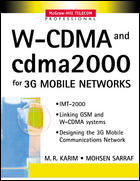W-CDMA and cdma2000 for 3G Mobile Networks
暫譯: W-CDMA 與 cdma2000 在 3G 行動網路中的應用
M.R. Karim, Mohsen Sarraf
- 出版商: McGraw-Hill Education
- 出版日期: 2002-04-29
- 售價: $2,580
- 貴賓價: 9.5 折 $2,451
- 語言: 英文
- 頁數: 384
- 裝訂: Paperback
- ISBN: 0071385134
- ISBN-13: 9780071385138
無法訂購
相關主題
商品描述
Excellent coverage: captures the gamut from propagation science to
network planning. -- Nikil Jayant, John Pippin Chair in Wireless Systems,
Georgia Tech
For those already installing 3G systems, I recommend it be rushed into
print. -- Reed Fisher, formerly of Bell Labs and father of the cell
phone
Engineers will find this is a much-needed integrated approach to
understanding 3G technologies. -- Ken Smolik, Technology Specialist, Banner
& Witcoff, Ltd.
This book gives network managers and 3G workers a select background in
spread spectrum technology, empowering them to make real-world design,
purchasing, and deployment decisions. Assuming only that W-CDMA is the preferred
interface, the authors make a point of grounding 3G technologies in the
fundamentals of propagation characteristics, physical layer functionalities, and
spectrum requirements, so readers can confidently tackle soft handover, power
control, sectorization, and message flows.
Written by authors with deep experience in data communications design and
development, this jargon-free look at W-CDMA:
* Spells out what providers
must know to enable wireless data speeds 40 times the current level
*
Shows how to integrate U.S., European, and Pacific Rim flavors of 3G for
worldwide roaming access
* Explains how spread spectrum functions best in
data transmission
* Covers vital links between GSM and W-CDMA
systems
* Reviews and unpacks IMT-2000 interface proposals
Worth its weight in paid consultants to wireless carriers, service
developers, systems engineers, and telecom managers, this book opens a window on
the implications of the air interface in the next-generation network.
Contents
Chapter 1: Introduction
Chapter 2: Propagation Characteristics of a Mobile Radio
Channel
Chapter 3: Principles of Wideband CDMA
(WCDMA)
Chapter 4: cdmaOne and
cdma2000
Chapter 5: The GSM System and General Packet
Radio Service (GPRS)
Chapter 6: Universal Mobile
Telecommunications System (UMTS)
Chapter 7: Evolution of
Mobile Communication Networks
Chapter 8: Call Controls
and Mobility Management
Chapter 9: Quality of Service
(QoS) in 3G Systems
Chapter 10: Network Planning and
Design
Chapter 11: Beyond 3G
Appendix: List of Abbreviations and Acronyms
Index
商品描述(中文翻譯)
**隨著服務提供商開始建設第三代和UMTS網絡,他們需要一位專家來理解複雜的協議和脫離上下文的技術報告**
*優秀的覆蓋範圍:涵蓋從傳播科學到網絡規劃的各個方面。* -- Nikil Jayant,喬治亞理工學院無線系統約翰·皮平講座教授
*對於已經在安裝3G系統的人,我建議迅速出版。* -- Reed Fisher,前貝爾實驗室成員及手機之父
*工程師會發現這是理解3G技術所需的綜合方法。* -- Ken Smolik,Banner & Witcoff, Ltd.技術專家
本書為網絡管理者和3G工作者提供了選擇性的擴頻技術背景,使他們能夠做出現實世界的設計、採購和部署決策。假設W-CDMA是首選接口,作者特別強調將3G技術根植於傳播特性、物理層功能和頻譜需求的基本原則,讓讀者能夠自信地處理軟切換、功率控制、區域劃分和消息流。
本書由在數據通信設計和開發方面擁有豐富經驗的作者撰寫,對W-CDMA進行了無行話的深入探討:
* 清楚說明提供商必須了解的內容,以實現無線數據速度達到當前水平的40倍
* 展示如何整合美國、歐洲和亞太地區的3G版本,以實現全球漫遊接入
* 解釋擴頻在數據傳輸中如何發揮最佳功能
* 涵蓋GSM和W-CDMA系統之間的重要聯繫
* 回顧並解析IMT-2000接口提案
對於無線運營商、服務開發者、系統工程師和電信經理來說,本書的價值不亞於付費顧問,為下一代網絡的空中接口影響提供了深入的見解。
**目錄**
第1章:介紹
第2章:移動無線電通道的傳播特性
第3章:寬帶CDMA(WCDMA)的原理
第4章:cdmaOne和cdma2000
第5章:GSM系統和通用分組無線服務(GPRS)
第6章:通用移動通信系統(UMTS)
第7章:移動通信網絡的演變
第8章:呼叫控制和移動性管理
第9章:3G系統中的服務質量(QoS)
第10章:網絡規劃和設計
第11章:超越3G
附錄:縮寫和首字母縮略詞列表
索引












